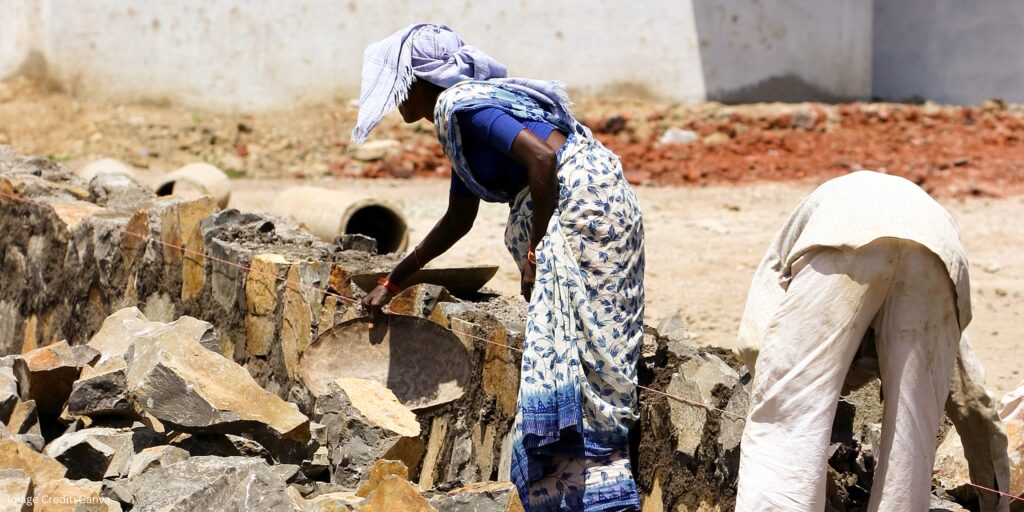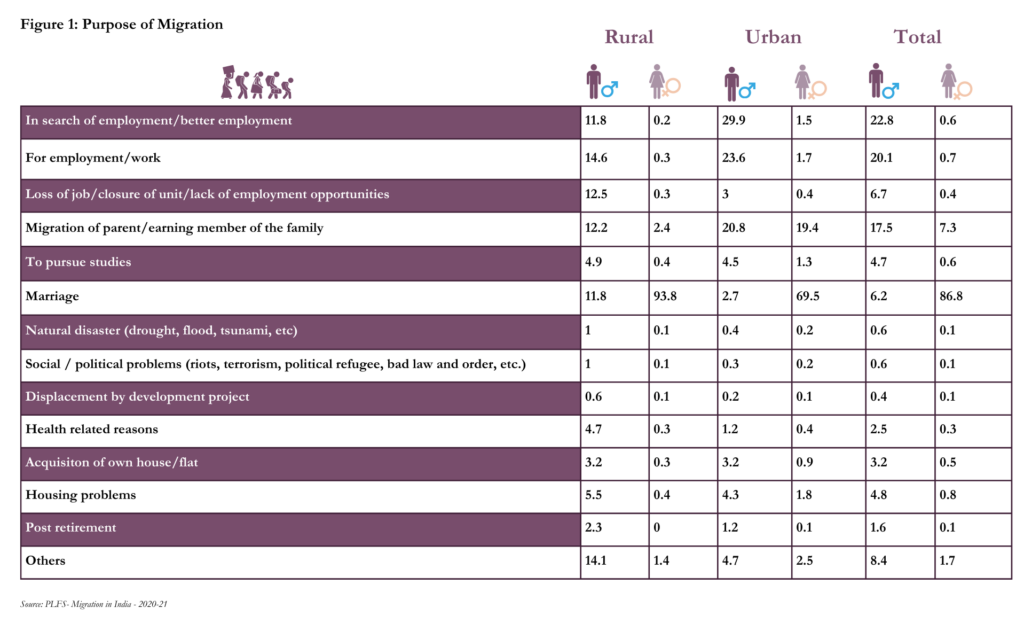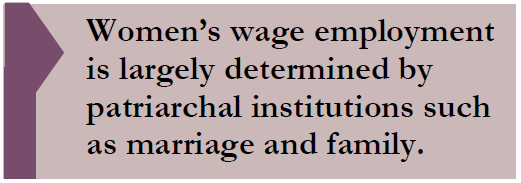
 Labour migration of women is yet to gain its due in the literature. This non-recognition is largely due to the issues with the macro data on migration, which follows a mono-casual approach to capture migration. The migration rate among women according to the most recent migration survey (GOI, 2020-21) is 47.9 percent for women, as against 10.7 percent of men. However, a huge share of female migrants (87 percent) is captured as marriage migrants and another 7 percent are associational migrants who have moved with their family (Table 1). Labour migration of women as per the macro data sources is negligible, roughly constituting only about 2 per cent of the total female migration. On the other hand, for male migration, employment and associated reasons are the most important ones constituting for about 50 percent of those who have migrated.
Labour migration of women is yet to gain its due in the literature. This non-recognition is largely due to the issues with the macro data on migration, which follows a mono-casual approach to capture migration. The migration rate among women according to the most recent migration survey (GOI, 2020-21) is 47.9 percent for women, as against 10.7 percent of men. However, a huge share of female migrants (87 percent) is captured as marriage migrants and another 7 percent are associational migrants who have moved with their family (Table 1). Labour migration of women as per the macro data sources is negligible, roughly constituting only about 2 per cent of the total female migration. On the other hand, for male migration, employment and associated reasons are the most important ones constituting for about 50 percent of those who have migrated.
 Marriage migration camouflages women’s contribution to the family and economy, both as economic agents and as critical drivers in social reproduction. Even when female migration for employment is acknowledged, the concepts and frameworks used for its analysis and understanding are largely based on male-centric models. The lack of reliable data is one of the reasons for the invisibility of women’s labour migration and the poor understanding of its specifics. The field-based literature on female migration has brought many insights on the labour migration of women. The heterogeneous nature of women’s migration and the correlation between the type of migration and sectors of employment are critical insights that these studies have established (Loess Schenk, 1995; CWDS, 2019). Migration in the contemporary period is noted to have led to relatively limited diversification of female occupations with strong social and class differentiation (Gothoskar, 2013). Given the gendered structure of employment and labour market institutions, who migrates, and the nature of migration are closely related; this cannot be more evident as in the case of migration for domestic work. The gendered understanding of housework and care work, with personal relations being critical in paid domestic work, saw rural women migrating and taking up such work. Poorly educated, and women largely from socially and economically marginalized groups dominate the sector (Neetha, 2019). Domestic work, though highly informal, does provide workers with continuous employment; thus, though these workers do not fall into the permanent settled, migrant category, they are mostly medium or long- term migrants. However, since wages from domestic work, being low and variable – are not enough to support families in the urban area, the relationship of the migrant with the rural area is found critical. Rural dependence could also be for childcare support, as migrating with children and ensuring their safety is a concern that women migrants at the lower rungs of the informal sector face. Economic dependence on the rural location is also important, which is evoked at the time of any personal crisis, which was evident in the context of the pandemic. Research on female migration for work has also brought new insights into the understanding of existing employment and labour relations and the need to engender this field. The interlocked nature of employment relationships with semi-feudal bondage and patriarchal practices is an important dimension in the recruitment and employment practices of women. The case of brick kiln and sugar cane workers, who are all migrants, has also brought forth how even progressive labour laws have not been able to accommodate women’s labour in such tied labour situations into its ambit (Teerink, 1995). In the jodi (male-female pair) system of employment, which is prevalent in these sectors, the contribution of women is tied to the male member. The piece rate wage system prevalent in these sectors denies migrant women access to any direct wage benefits.
Marriage migration camouflages women’s contribution to the family and economy, both as economic agents and as critical drivers in social reproduction. Even when female migration for employment is acknowledged, the concepts and frameworks used for its analysis and understanding are largely based on male-centric models. The lack of reliable data is one of the reasons for the invisibility of women’s labour migration and the poor understanding of its specifics. The field-based literature on female migration has brought many insights on the labour migration of women. The heterogeneous nature of women’s migration and the correlation between the type of migration and sectors of employment are critical insights that these studies have established (Loess Schenk, 1995; CWDS, 2019). Migration in the contemporary period is noted to have led to relatively limited diversification of female occupations with strong social and class differentiation (Gothoskar, 2013). Given the gendered structure of employment and labour market institutions, who migrates, and the nature of migration are closely related; this cannot be more evident as in the case of migration for domestic work. The gendered understanding of housework and care work, with personal relations being critical in paid domestic work, saw rural women migrating and taking up such work. Poorly educated, and women largely from socially and economically marginalized groups dominate the sector (Neetha, 2019). Domestic work, though highly informal, does provide workers with continuous employment; thus, though these workers do not fall into the permanent settled, migrant category, they are mostly medium or long- term migrants. However, since wages from domestic work, being low and variable – are not enough to support families in the urban area, the relationship of the migrant with the rural area is found critical. Rural dependence could also be for childcare support, as migrating with children and ensuring their safety is a concern that women migrants at the lower rungs of the informal sector face. Economic dependence on the rural location is also important, which is evoked at the time of any personal crisis, which was evident in the context of the pandemic. Research on female migration for work has also brought new insights into the understanding of existing employment and labour relations and the need to engender this field. The interlocked nature of employment relationships with semi-feudal bondage and patriarchal practices is an important dimension in the recruitment and employment practices of women. The case of brick kiln and sugar cane workers, who are all migrants, has also brought forth how even progressive labour laws have not been able to accommodate women’s labour in such tied labour situations into its ambit (Teerink, 1995). In the jodi (male-female pair) system of employment, which is prevalent in these sectors, the contribution of women is tied to the male member. The piece rate wage system prevalent in these sectors denies migrant women access to any direct wage benefits.
Further, the Sumangali system (Vaigai, 2016) noted in the textile industry in South India, which entails employment contracts linked to the system of dowry and marriage, and the documented preference for unmarried girls in many sectors and occupations across the country, clearly shows how women’s wage employment, even when based on individual units of labour, are largely determined by patriarchal institutions such as marriage and family. These systems call for developing new perspectives on specific forms of bondage to analyse women migrants, which are outside the existing frameworks. Poverty, debt, decline in income, lack of local employment, and loss of such employment are the main reasons for female labour migration (CWDS, 2019).
For many poor women migrants, there is a reinforcement of social and cultural inequality with poor wages and adverse terms of employment and thus their migrant status worsens their overall status. Even in these contexts, women migrants do exercise agency at different levels. Within the extremes of autonomy to complete subordination, a spectrum exists where some women can negotiate better depending upon several factors. Personal profiles such as education, age, class background, and social capital contribute to their autonomous status as workers and in exercising agencies both in workplaces and families. However, the literature has also noted the autonomous migration of single women as a strategy to come out of the patriarchal controls and attain social and economic mobility (Chowdhory, 2022). It is true that such migration has not been of sufficient order to challenge the centrality of the patriarchal order in women’s work and migration.
 Women are also active agents or mediators in labour migration, and this has been established in the context of paid domestic work, the garment industry, and other feminized sectors. In a society where oppressive and caste- based notions of honour exist, young women labour migrants are subjected to a high degree of stigma, especially when they are in the lower rungs of the informal sector (Mazumdar & Neetha, 2020). In this context, it is critical to highlight developments that have adverse impacts on single, autonomous migration such as anti-trafficking laws which, if not implemented progressively, may subvert women’s freedom to migrate for work.
Women are also active agents or mediators in labour migration, and this has been established in the context of paid domestic work, the garment industry, and other feminized sectors. In a society where oppressive and caste- based notions of honour exist, young women labour migrants are subjected to a high degree of stigma, especially when they are in the lower rungs of the informal sector (Mazumdar & Neetha, 2020). In this context, it is critical to highlight developments that have adverse impacts on single, autonomous migration such as anti-trafficking laws which, if not implemented progressively, may subvert women’s freedom to migrate for work.
References:
Center for Women’s Development Studies (2019): Women. Migrating in India: Evidence from Odisha, Research Monograph (collaboration with LSHTM),
https://www.cwds.ac.in/wp-content/uploads/2019/10/Women-Migrating-in-Inida.pdf.
Chowdhory, N., Sabur Ali M., Kaur, R., Kajla, M., Kumari, N., Tiwari, B., & Ishaq, S. (2022). Gendering Migration: Evaluating Empowerment of Single Migrant Women. Social Change, 52(1), 24-39.
Gothoskar, S. (2013). The plight of domestic workers: confluence of gender, class and caste hierarchies. Economic and Political Weekly 48 (22): 63–75.
Government of India, NSO (2021-22): Migration Report, PLFS, 2021−22.
Loess Schenk, Sandbergen (ed), (1995) Women and Seasonal Labour Migration, Sage, New Delhi.
Mazumdar, Indrani & Neetha, 2020, Crossroads and Boundaries: Labour Migration, Trafficking and Gender, Economic and Political Weekly 55 (20): 66–75
Neetha N. (ed) 2019. Working at others’ homes: the specifics and challenges of paid domestic work. Tulika Books, New Delhi.
Vaigai, R (2016): “Girl Workers in ‘Sumangali Scheme’ of Textile Industry, Tamil Nadu— Claiming Equality through Litigation,” mimeo.
____________________________________________
Neetha N. is Professor at the Centre for Women’s Development Studies (CWDS), New Delhi. Her research focuses on women’s employment, women workers in the informal sector, domestic workers, unpaid domestic and care work, female labour migration and gender statistics. She has published extensively in national and international books and journals.